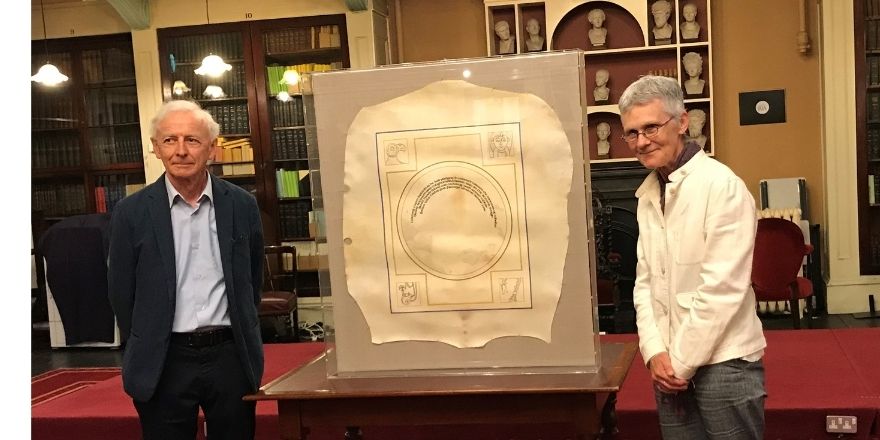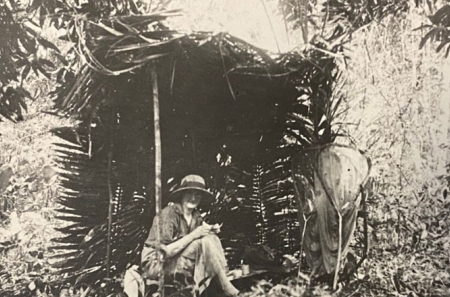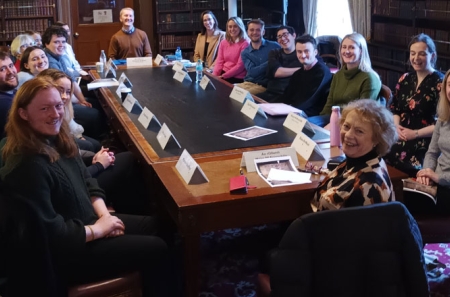
Artworks to mark the feast of Colm Cille
09 June 2021The artworks were commissioned as part of the Colm Cille 1500 commemoration and were received in Academy House today.
Two of the commissions by the Royal Irish Academy with the support of the Department of Foreign Affairs were received today in Academy House to mark the feast Of Colum Cille. The artworks were commissioned as part of the Colm Cille 1500 commemoration.
Caim Chaluim Chille Chaoimh / The encompassing of Columba the Kindly / Cuimsiú Cholm Cille Chaoimh
Julie Fowlis, Éamon Doorley, Zoë Conway and John McIntyre have come together at the invitation of the Royal Irish Academy’s Committee for Irish Language, Literature and Celtic Cultures to create a truly memorable new piece of music to celebrate Colm Cille 1500. The commission was enabled by the kind assistance of the Department of Foreign Affairs. Their piece is based on a text from Alexander Carmichael’s Carmina Gadelica, a multi-volume collection of Gaelic prayers, incantations, charms and songs collected in the Highlands and Islands of Scotland over one hundred years ago. The musicians have also woven into the text some words from a blessing from the Middle-Irish period. Their composition bridges the Sea of Moyle and generations of tradition in a contemporary and layered arrangement using voices, guitar, bouzouki, violin and oboe to commemorate the remarkable Columba – a man who left an indelible mark on the life, literature and landscape of both Ireland and Scotland.
In the video they have made to accompany their composition, the four musicians and singers have invited artist Ellis O’Connor to respond in paint, inspired by the music they have created. It is an enchanting experience.
Tá na ceoltóirí céimiúla Julie Fowlis, Éamon Doorley, Zoë Conway agus John McIntyre i ndiaidh píosa úrnua spreagúil ceoil a chumadh mar fhreagra ar chuireadh ó Choiste Léann na Gaeilge, Litríocht na Gaeilge agus na gCultúr Ceilteach in Acadamh Ríoga na hÉireann chun Colm Cille 1500 a chomóradh. Is le cabhair ó Roinn Gnóthaí Eachtracha na hÉireann a rinneadh an coimisiún seo. Tá an píosa seo cumadóireachta bunaithe ar théacs ón bhailiúchán il-imleabhair le Alexander Carmichael Carmina Gadelica a chuimsíonn orthaí, amhráin, paidreacha agus beannachtaí a bailíodh i nGaeltacht na hAlban corradh agus céad bliain ó shin. Tá curtha leis an téacs ag na ceoltóirí trí ábhar ó phaidir Mheán-Ghaeilge a fhí tríd. Tá an dá thaobh de Shruth na Maoile tugtha leo acu agus dúchas na gcianta mar an gcéanna chun cóiriú comhaimseartha agus ilghnéitheach a dhéanamh agus feidhm á baint as guthanna, giotár, bouzouki, veidhlín agus óbó. Is ceiliúradh fónta é seo ar an fhear eaglasta a d’fhág an oiread sin anála ar shaol, ar shaíocht agus ar thírdhreach na hÉireann agus na hAlban araon.
San fhíseán a d’ullmhaigh na ceoltóirí mar léiriú ar an saothar ceoil, d’iarr siad ar an ealaíontóir Ellis O’Connor géilleadh don inspioráid a chothaigh an ceol nuachumtha seo agus dul i mbun peintéireachta dá réir. Is álainn agus is draíochtúil an comhdhéanamh é.
Cruinne Cholm Cille

This artwork by master calligrapher Timothy O’Neill incorporates lines from an Early Irish poem in praise of Colum Cille where he is depicted on his journey between Ireland and Scotland, a reference to the story of the saint’s exile from Ireland. The circle marks his world and the shared traditions of communities on both sides of the Sea of Moyle. Produced on vellum (calfskin parchment) and mounted on linen, the artwork embodies aspects of the economy and material culture of the Columban era. The majuscule script harks back to the earliest Latin manuscripts and was always used for copying one of the most important early Columban texts, the eulogy Amrae Coluimb Chille. The artwork also references images from the most famous manuscripts associated with the saint, An Cathach, The Book of Durrow, The Book of Kells and the 16th century biography of Colum Cille by Maghnas Ó Domhnaill, Betha Colaim Chille, reflecting Colum Cille’s enduring influence on the scribal tradition.
Baineann an saothar seo leis an máistirchallagrafaí Timothy O’Neill earraíocht as línte ó dhán molta Sean-Ghaeilge ina léirítear Colm Cille ar a thuras idir Éire agus Albain, tagairt do scéal deoraíochta an naoimh. Tá an ciorcal ina léiriú ar an gcruinne inar mhair sé agus ar na comhthraidisiúin atá ag pobail ar an dá thaobh de Shruth na Maoile. Trí úsáid a bhaint as veilleam (pár de chraiceann lao) agus é suite ar línéadach, tarraingíonn an saothar aird ar ghnéithe de gheilleagar agus de chultúr ábhartha aois Cholm Cille féin. Tá an mhórscript ina scáthán ar na lámhscríbhinní Laidine is luaithe agus bhaintí úsáid aisti i gcónaí nuair a bhíodh cóipeanna á ndéanamh de cheann de na luath-théacsanna is tábhachtaí a bhaineann le Colm Cille, an dán molta Amrae Coluimb Chille. Úsáideann an saothar íomhánna ó na lámhscríbhinní is cáiliúla a shamhlaítear leis an naomh, An Cathach, Leabhar Dharú, Leabhar Cheanannais agus an bheatha a scríobh Maghnas Ó Domhnaill sa 16ú haois, Betha Colaim Chille, chun aird a tharraingt ar thionchar leanúnach Cholm Cille ar thraidisiún na lámhscríbhinní.


